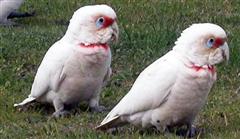Corella - Long Billed
Slender Billed Corella, Slender Billed Cockatoo Scientific Name: Cacatua tenuirostris tenuirostris
Thu, 3rd July, 2025 - 7:55 am GMT
Sponsor Ads:

Alternative Name
Slender Billed Corella, Slender Billed Cockatoo Scientific Name: Cacatua tenuirostris tenuirostrisBasic Info
Long-billed Corellas have long upper mandibles, of course! The entire bird grows to about 38 centimeters in length. They have white plumage, which is yellowish under the tail and wings. There is a large blue-gray area about the eye, which lacks feathers. Long-billed Corellas are characterized by the red coloring they have about their necks and in the area of their nostrils. Long-billed Corellas have a red crescent on their breasts and red foreheads. Their white crests are rather small. Male Long-billed Corellas generally have longer beaks than do females, and more red color in addition to being generally larger.
Health
Because Long-billed Corellas are so social, they will need plenty of love and attention from you and will do well when kept in pairs. Breeding Long-billed Corellas in captivity need a variety of nesting boxes. It may be difficult to get them to breed because many times they are not happy with the nesting options they have. Provide peat moss, dirt and wood shavings as nesting material. A typical clutch consists of two or three oval shaped, white eggs, which incubate for 24 days. The young fledge at about 56 days.Habitat
N/ABehavior
The Long-billed, or Slender-billed Corella is a lovely Cockatoo who lives both in the wild and in captivity throughout Australia. Long-billed Corellas are generally found near watercourses in grassy areas or open woody areas. They are highly social, gregarious birds and gather at feeding sites in flocks of hundreds of birds! Often, Long-billed Corellas will associate with the Sulphur-crested Cockatoo. While feeding, one bird will remain in a tree and keep watch while the others feed. They only feed during the cooler hours of the day, preferring to rest at midday in shade. Long-billed Corellas, when disturbed, will shriek loudly while taking wing. From July to November, Long-billed Corellas breed, making their nests in hollow treetops or branches. They have been observed making burrows in soft dirt banks when they cannot find a suitable tree. Both the male and female Long-billed Corella tend to the young and sit on the eggs!Origin
AustraliaHistory
In cultivated areas, Long-billed Corellas can seriously harm grain or millet and rice fields, and are endangered in some areas because they are persecuted as agricultural pests. First recognized by Kuhl in 1820, Long-billed Corellas are native to southeastern Australia.Common Foods
They feed mostly on roots and onion grass supplemented with all sorts of seeds, vegetation and fruits in addition to insects.Sponsor Ads:
Most men and nations die lying down. -- Unknown
Corella - Long Billed
Coded by: BGID® | ALL RIGHTS RESERVED Copyright © 2000-2025
Disclaimer | Privacy | Report Errors / Contact | Credits








 President of the United States of America - Real Estate mogul, Pageant owner and now one of the most controversial men in political history.
President of the United States of America - Real Estate mogul, Pageant owner and now one of the most controversial men in political history.  Global warming has been in and out as the "latest" hot topic for many years. It is, according to modern scientists, the result of man-made industrial pollutants, clearing forested areas, agriculture, etc. But now they are thinking it started way before the Industrial Revolution...
Global warming has been in and out as the "latest" hot topic for many years. It is, according to modern scientists, the result of man-made industrial pollutants, clearing forested areas, agriculture, etc. But now they are thinking it started way before the Industrial Revolution...  Politician, US Vice President and President of the USA - Joseph Robinette Biden Jr.
Politician, US Vice President and President of the USA - Joseph Robinette Biden Jr.  versus
versus  Russia: 'The Evil Empire'? Are they all that bad or is it just the USA trying to portray Russia as bad because they are a world power with land bigger and a society very different from the USA ideal?
Russia: 'The Evil Empire'? Are they all that bad or is it just the USA trying to portray Russia as bad because they are a world power with land bigger and a society very different from the USA ideal? 
 Corona virus
Corona virus 
 Users with wide screen monitors can benefit from more content on every page.
Users with wide screen monitors can benefit from more content on every page.